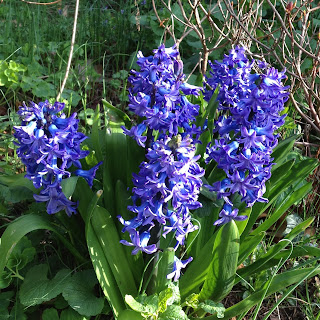What’s actually in the scent of a flower?
It’s probably not a question most people ask, but if you’re interested in the answer I’m presenting here a discussion of the components of the scent of hyacinth flowers.
 |
| Hyacinths in flower in the Pell Wall garden |
Most of these individual chemicals are available to the perfumer attempting to recreate the scent but as you can see the proportions vary according to the collection technique used. All the methods essentially involve collecting the scented air from above the flower – what is known in the trade as the headspace – and then working out what is in it, but there are a variety of means of doing that and they don’t all yield the same results. These results all came from blue hyacinth by the way.
Benzaldehyde 1.2 – 2.3
Cymene 0.2
Limonene 0.2 – 1.2
Benzyl alcohol 1.5 – 2.5
phenylacetaldehyde 1 – 1.1
trans-Ocimene 1 – 7.2
Phenyl ethyl alcohol 22.2 – 25.5
Benzyl acetate 13.7 – 20.1
Aldehyde C-10 0.5 – 0.6
Phenylpropyl alcohol 0.7 – 1.4
Phenyl ethyl acetate 2.4 – 7.7
Cinnamic aldehyde 2.9 – 4.6
Cinnamic alcohol 9 – 16
Methyl 2-methoxybenzoate 0.7 – 0.8
Eugenol 0.6 – 0.8
1,2,4-Trimethoxy benzene 7.2 – 11.6
Methyl eugenol 0.6 – 0.9
Cinnamyl acetate 0.2 – 0.5
alpha-Farnesene 5.1 – 6.3
Benzyl benzoate 6.3 – 9.3
Phenylethyl benzoate 1.1
I researched this when I was setting out to make my own hyacinth based fragrance – Persian Prince for my Spring Flowers Collection. You might reasonably wonder why I would go to so much trouble – surely you can just get hold of the essence of the natural flower and use that? Well with some flowers that’s certainly possible, though often the resulting essence does not smell much like putting your nose to the flower. In this case though according to White Lotus there is no real Hyacinth being offered anywhere today and I’m inclined to agree with them.
So instead it’s just a question of mixing all the elements on the list and hey-presto you have a hyacinth perfume?
Well not quite – for one thing the flower does not have to obey the safety rules set out by IFRA and summarised in this post. If you copy the flower scent exactly you end up with a perfume that might cause skin irritation when you spray it on yourself. Plus some of the chemicals are difficult to get hold of or not fully stable and of course, unlike the flower, your perfume isn’t going to be continually made on your skin and released into the air in a constant stream.
So some adjustments are needed to make it last on the skin, project out from it and still smell like the flower it is supposed to. Having the list certainly makes re-creating the scent a great deal easier though.
So now you know – anyone care to guess which is the single chemical from that list that most accurately represents the scent of hyacinth to the human nose?
